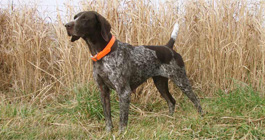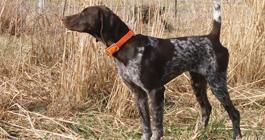Pre-Season Hunting Dog Conditioning
Dog Health and More Birds
With the hunting season just around the corner, now is a good time to start thinking about conditioning your canine athlete for early season performance. We wouldn’t think about going out and running ten miles one day without some prior physical training, and it doesn’t make any more sense to expect it from our dogs. By getting our dogs in shape before the season, we go a long way toward ensuring a healthier and more effective hunting companion.
A high level of physical fitness contributes to a dog’s mental fitness because a tired dog will focus less on commands and finding birds. Risk of injury is also reduced during both training and hunting when muscles and tendons are strong and joints well lubricated. Training the body to recover from a work out will prepare your dog for longer hunts and more days hunting.
Before You Start
Before you get to work, it is important to consider three factors that can have a tremendous impact on your dog’s ability to function at a high level. We recommend you think of the following before starting any conditioning program.
See Your Vet – A good overall examination will ensure that your dog is fit for training and free from clinical problems and parasites that could adversely affect health and performance.
Choose A Quality Food – Rather than focus on a specific brand let’s just agree that nutrition is very important. Your dog must consume high quality protein to build and repair muscle tissue while supporting his immune system and overall health with high quality vitamins and trace minerals.
Replenish Fluids – Making sure that your dog stays hydrated may be the single greatest factor in health during hunting. If he won’t drink water, find a good hydration supplement to encourage him to drink.
3 Steps To Bird Dog Fitness
Now we’ll get into the meat of the conditioning program. We base our conditioning program around three basic areas that complement one another for a complete workout of the entire body and organs. You don’t need to do everything every day but you should try to do something each day.
Roadwork – We road our dogs on gravel early in the morning when traffic is sparse. We hook four dogs to a harness to pull a four-wheeler three miles with the engine off. This helps build endurance and strength while conditioning the paws for the rigors of hunting. This should be done at least three days per week.
Fieldwork – During the heat of the afternoon, we “freelance” our dogs by letting them run and hunt in large pastured areas at a slow but steady pace. This allows the dog to improve lung capacity and scenting abilities at the same time. It is important to condition a dog in the same heat of the day that they will be exposed to during hunting. We freelance our dogs only on days that we don’t do roadwork and for no more than 45 minutes.
Swimming – We swim our dogs several nights a week to work different muscle groups while creating less stress on joints and tendons. We have noticed a big improvement in performance since introducing this to our program. We limit this to no more than an hour, and often swim with them.
Developing a solid conditioning program is very important to the health and longevity of our canine friends. Make sure that you work your dog into condition over a 30-45 day period before the start of the season. In the end, you’ll have a much better performing dog and a more successful hunting season.










